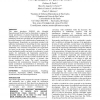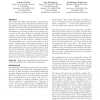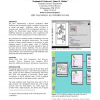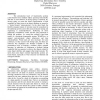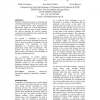HT
1998
ACM
14 years 3 months ago
1998
ACM
This paper introduces XHMBS (the eXtended Hyperdocument Model Based on Statecharts) to support the formal specification of general hypermedia applications. XHMBS uses a novel form...
HT
1998
ACM
14 years 3 months ago
1998
ACM
The historical development of hypermedia systems can be rized as a series of successive abstractions of functionality away from the "core" hypermedia server, often resul...
HT
1998
ACM
14 years 3 months ago
1998
ACM
Reuse is increasingly strategic for reducing cost and improving quality of hypermedia design and development. In this paper, based on the design and development of a real hypermed...
HT
1998
ACM
14 years 3 months ago
1998
ACM
Annotation is a key way in which hypertexts grow and increase in value. This paper first characterizes annotation according to a set of dimensions to situate a long-term study of ...
HT
1998
ACM
14 years 3 months ago
1998
ACM
The World Wide Web grows through a decentralized, almost anarchic process, and this has resulted in a large hyperlinked corpus without the kind of logical organization that can be...
HT
1998
ACM
14 years 3 months ago
1998
ACM
We have implemented a browser companion called PadPrints that dynamically builds a graphical history-map of visited web pages. PadPrints relies on Pad++, a zooming user interface ...
HT
1998
ACM
14 years 3 months ago
1998
ACM
The presentation layer of hypermedia systems could benefit from standard object querying functionality and this is most effective if strong typing is enforced. By strong typing we...
HT
1998
ACM
14 years 3 months ago
1998
ACM
The MAPA system provides improved navigation facility for large web sites. It extracts a hierarchical structure from an arbitrary web site, with some minimal user assistance, and ...
HT
1998
ACM
14 years 3 months ago
1998
ACM
HT
1998
ACM
14 years 3 months ago
1998
ACM
In this paper we propose and study a framework for evaluating Hypermedia Application Development and Management Systems (HADMS) in relation to specific application requirements. W...
